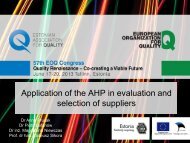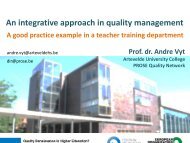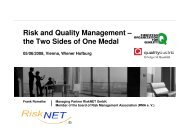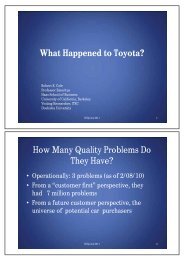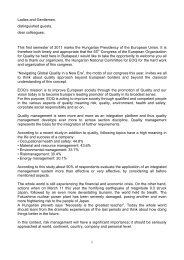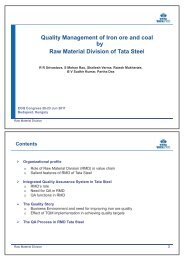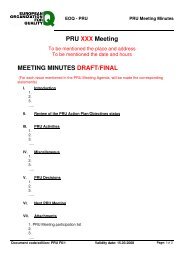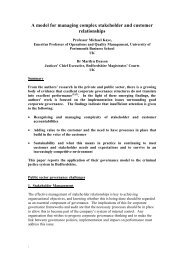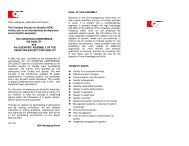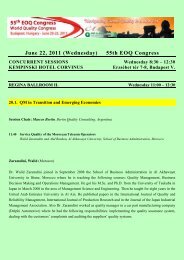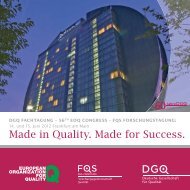Lorena Para González, Hrm and Efqm Model - EOQ
Lorena Para González, Hrm and Efqm Model - EOQ
Lorena Para González, Hrm and Efqm Model - EOQ
You also want an ePaper? Increase the reach of your titles
YUMPU automatically turns print PDFs into web optimized ePapers that Google loves.
AUTHORS:<br />
PHD STUDENT LORENA PARA GONZÁLEZ<br />
(University Centre of Defence at the Spanish Air Force Academy)<br />
PHD ÁNGEL RAFAEL MARTÍNEZ-LORENTE<br />
(Technical University of Cartagena)<br />
PHD DANIEL JIMÉNEZ-JIMÉNEZ (University of Murcia)<br />
1
INTRODUCTION<br />
• Human resources: competitive advantage for<br />
companies.<br />
• Continuous improvement <strong>and</strong> TQM.<br />
• EFQM model “People criterion”.<br />
• Relationship between “People criterion” <strong>and</strong><br />
organizational performance.<br />
2
AIM<br />
• Analyze the role of the personnel function on the<br />
organizational performance, contextualizing this<br />
research on EFQM model of excellence, emphasizing<br />
the task of human capital on it.<br />
3
EFQM MODEL OF EXCELLENCE<br />
• Aim: to help European companies to be more competitive <strong>and</strong> to<br />
demonstrate that Excellence is essential.<br />
4
HUMAN RESOURCES ON THE EFQM<br />
MODEL (I)<br />
• Positive empirical evidence: effect of HRM on<br />
performance <strong>and</strong> results.<br />
• People criterion is divided in subcriteria:<br />
1.- Planning, management <strong>and</strong> improvement of HR<br />
2.- Identification, development <strong>and</strong> maintenance of<br />
knowledge <strong>and</strong> capability of persons.<br />
3.- Implication <strong>and</strong> assumption of liability.<br />
4.- Existence of dialogue among people.<br />
5.-Compensation, acknowledgment <strong>and</strong> attention.<br />
Relationship among enablers <strong>and</strong> results supported.<br />
5
HUMAN RESOURCES ON EFQM MODEL<br />
(II)<br />
• EFQM model helps to get a major effectiveness of the<br />
job.<br />
• A company could achieve a superior satisfaction of<br />
their employees provided that it is concentrated on the<br />
improvement of the completion of each worker<br />
(Eskildsen & Dahlgaard, 2000):<br />
H1: People criterion in the EFQM model is<br />
positively related to organizational performance.<br />
6
HUMAN CAPITAL AND THE COMPETITIVE<br />
ADVANTAGE OF THE FIRM (I)<br />
• Human capital: people possess skills <strong>and</strong> abilities that<br />
provide a major performance to firms.<br />
• Human resources can add value to the company, since<br />
they are unique <strong>and</strong> difficult to replicate or substitute.<br />
• Human capital value: capacity to improve the<br />
efficiency <strong>and</strong> effectiveness of the firm.<br />
• Human capital uniqueness: unique routines <strong>and</strong><br />
procedures that have limited value outside the firm.<br />
7
HUMAN CAPITAL AND THE COMPETITIVE<br />
ADVANTAGE OF THE FIRM (II)<br />
• “Core employees”: firm- specific human capital.<br />
• Positive impact of human capital on performance (Hitt<br />
et. al., 2001), especially valuable <strong>and</strong> specific human<br />
capital:<br />
H2: Firm-specific human capital is positively<br />
related to organizational performance.<br />
8
HUMAN CAPITAL AND THE COMPETITIVE<br />
ADVANTAGE OF THE FIRM (III)<br />
• Valuable human capital relates to the capability to<br />
develop a better efficiency of the firm. This perspective<br />
asserts that in order to obtain a higher firm<br />
performance, the abilities, competences <strong>and</strong> skills of<br />
the employees have a key role (Buller <strong>and</strong> McEvoy,<br />
2012).<br />
9
HUMAN CAPITAL AND THE COMPETITIVE<br />
ADVANTAGE OF THE FIRM (IV)<br />
• An appropriate personnel recruitment <strong>and</strong> selection<br />
policy, along with a workforce that is trained, involved<br />
<strong>and</strong> committed to quality <strong>and</strong> to the improvement of<br />
the activities of the organization must have an effect<br />
on its human capital <strong>and</strong> the improvement of the<br />
organization’s key processes.<br />
H 3 : Valuable human capital is positively related to<br />
organizational performance.<br />
10
HUMAN CAPITAL AND THE COMPETITIVE<br />
ADVANTAGE OF THE FIRM (V)<br />
• Excellent companies should count with personnel, that have<br />
knowledge <strong>and</strong> competences valuable <strong>and</strong> specific for each<br />
company.<br />
• Design every organizational system paying attention to<br />
attracting, developing <strong>and</strong> motivating the best people (Lawler<br />
III, 2009): COMPETITIVE ADVANTAGE.<br />
• Nabitz et. al. (2009) show that some measures for people<br />
criterion of EFQM model affect positively human capital:<br />
H4: People criterion in the EFQM model is positively<br />
related to human capital.<br />
11
HUMAN CAPITAL AND THE COMPETITIVE<br />
ADVANTAGE OF THE FIRM (VI)<br />
• Buller <strong>and</strong> McEvoy (2012) found in their research that<br />
certain HRM practices suggested by the People<br />
criterion of the EFQM model, such as an incentive<br />
compensation or performance assessment, contribute<br />
positively to create distinctive competences.<br />
• Firm-specific human capital is considered as an<br />
essential intangible resource of an organization,<br />
because is difficult to imitate due to the complexness<br />
of the creation of distinctive competences (Chisholm<br />
<strong>and</strong> Nielsen, 2009).<br />
H 5 : People criterion in the EFQM model is positively<br />
related to firm-specific human capital.<br />
12
PROPOSED MODEL<br />
13
METHODOLOGY (I)<br />
• Population <strong>and</strong> Sample: 3.814 companies from SABI<br />
database with more than 100 employees.<br />
• Structured questionnaire via webpage led to<br />
following managers: quality, production, human<br />
resources <strong>and</strong> marketing.<br />
• Significant correlation of 0.823 (p=0.01) between<br />
number of companies at each sector in the sample <strong>and</strong><br />
population.<br />
• Likert scale of 5 points.<br />
14
METHODOLOGY (II)<br />
• Measures:<br />
- EFQM people criterion: 10 items from the subcriteria.<br />
- Value <strong>and</strong> uniqueness of human capital: human<br />
resource architecture of Lepak <strong>and</strong> Snell (2002).<br />
- Performance: 4 items for each four results criteria<br />
of EFQM performance criteria.<br />
- Control variables: organizational size <strong>and</strong> antiquity.<br />
15
METHODOLOGY (III)<br />
• Analysis: structural equations modeling to test the<br />
hypotheses, using EQS 6.1 software.<br />
Mean<br />
SD<br />
Lowest<br />
t-value<br />
Cronbach<br />
alpha<br />
SCR a<br />
AVE b<br />
Personnel criteria 4,0756 ,44165 - ,862 - -<br />
Human capital value 3,7085 ,53102 6,647 ,809 ,824 ,501<br />
Human capital uniqueness 3,2736 ,69811 11,151 ,912 ,911 ,672<br />
Performance 3,9956 ,40776 5,982 ,788 ,798 ,510<br />
χ 2 (74)=110.280, NNFI=0.968, CFI=0,974, IFI=0,974, GFI = 0,927, RMSEA=0,050<br />
a<br />
Scale composite reliability (qc=(Aki)2 var (n)/[(Aki)2 var (n) +Ahii]; (Bagozzi <strong>and</strong> Yi, 1988)<br />
b<br />
Average variance extracted (qc=(Aki)2 var (n)/[(Aki)2 var (n) +Ahii]; (Fornell <strong>and</strong> Larcker, 1981)<br />
16
RESULTS<br />
• H1 supported: companies that follow HR policies mentioned in people<br />
criterion of EFQM will obtain better results.<br />
• H2 <strong>and</strong> H3 supported: human capital value <strong>and</strong> uniqueness are<br />
important to obtain better results. EFQM model incoporates HR policies<br />
that help to generate human capital in organizations.<br />
Paths<br />
St<strong>and</strong>ardized<br />
coefficient<br />
Td Hypothesis<br />
People criterion → Performance ,418 4,705 Supported<br />
People criterion→ HC value ,393 4,307 Supported<br />
People criterion→ HC uniqueness ,355 4,685 Supported<br />
HC value → performance ,149 2,049 Supported<br />
HC uniqueness→ performance ,248 3,270 Supported<br />
Value <strong>and</strong> uniqueness human capital will play a mediator role for<br />
emphasizing the effects of human management policy in EFQM over<br />
organizational performance.<br />
17
RESULTS (II)<br />
• H4 <strong>and</strong> H5 supported: for a successful<br />
implementation of an excellence model, it is crucial<br />
that the executives acquired a role of “executives of<br />
persons”. The aim is to create HRM practices aligned<br />
with strategy, connecting effective <strong>and</strong> motivated<br />
employees with the organizational strategy, improving,<br />
therefore, performance<br />
18
CONCLUSIONS<br />
- HRM play a key role in firm’s competitive advantage.<br />
- Human capital value <strong>and</strong> uniqueness create a<br />
competitive advantage for the firm.<br />
- Positive relation among personnel management <strong>and</strong><br />
organizational results.<br />
- An application of the principles included in the<br />
“people criterion” of EFQM model increases the<br />
satisfaction of employees.<br />
- HC value <strong>and</strong> uniqueness play a mediation role in<br />
the relationship between people <strong>and</strong> performance<br />
criteria in the EFQM model.<br />
19
CONCLUSIONES (II)<br />
FUTURE RESEARCH<br />
• Examine which HRM practices are linked to the model<br />
<strong>and</strong> their impact to organizational performance.<br />
• Analyze what type of organizational culture is<br />
required to foster the relationships of the model.<br />
• Compare which HRM practices are derived from<br />
EFQM <strong>and</strong> TQM or ISO norms.<br />
20




